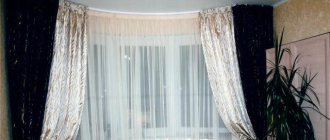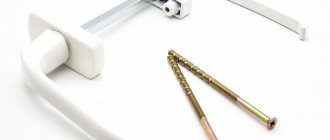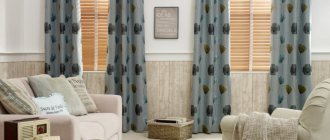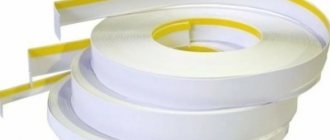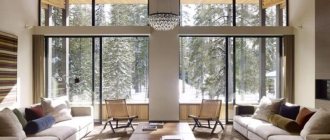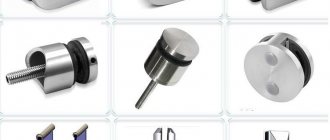Stucco molding, known from classical interiors, has penetrated into other styles, where it has become especially appropriate for the ceiling space. Ceiling stucco gives the room a special sophistication and at the same time adjusts the proportions of the room. We will understand what materials are used to create stucco decoration, what types of stucco molding exist, and how to decorate ceilings correctly.
Two-level ceiling with stucco Source pinimg.com
Manufacturing materials
Stucco patterns on the ceiling are a great way to create an accent in any interior and highlight the taste of the owners. For the manufacture of ceiling decor, three types of materials are used, which determine the performance characteristics of the noble finish.
Gypsum
Since Antiquity, this natural mineral (like its granular variety, alabaster) has been a traditional material for creating decorative elements in architecture. Gypsum ceiling molding has remained relevant due to the following strengths:
- Using gypsum, complex decorative details with a high degree of detail are created. High-quality matrices (forms) allow you to obtain the smallest patterns with clear relief.
- If treated with care, the ceiling finish will last for many decades.
- Gypsum is environmentally friendly and does not emit volatile compounds hazardous to health. It is able to regulate the microclimate by absorbing and releasing atmospheric moisture.
- Natural material is non-flammable and therefore fireproof.
Stucco on a plasterboard ceiling Source amazonaws.com
- Gypsum has minimal linear expansion, and its dimensions do not change with temperature changes.
- Plaster patterns can be painted and repainted - an easy way to update your interior.
- Gypsum is a repairable material: cracks, accidental chips or other defects can be corrected without reducing quality
The following properties of gypsum stucco are considered disadvantages:
- Large weight, due to which a lot of time is spent on installation, and for reliable fixation, special glue and dowel screws are required.
- Gypsum is capable of accumulating excess moisture and deteriorating, so products treated with water-repellent compounds are chosen for the bathroom and kitchen.
- To ensure that the gypsum decor remains unchanged, its protective layer is periodically renewed and the surface is painted.
- Complex plaster parts require special, precise molds for production. The complexity of the process is the reason for the high cost of products.
Fragment of floral decoration Source design-homes.ru
Foam plastic (expanded polystyrene)
Using foam molding is another way to make the ceiling stylish and elegant. The main attractive advantage of the decor is the price; this is the most accessible material. In addition to accessibility, one of the advantages is light weight; lightweight parts are mounted on any ceiling, including tension structures. A significant advantage is resistance to moisture.
The reason for the disadvantages of expanded polystyrene is its structure. The material consists of many small balls, the space between which is filled with air. This structure provides the main disadvantage of foam plastic - fragility, due to which the product breaks under the slightest load; Even wiping it needs to be done very carefully.
Simplified detailing is a sign of foam plastic Source squarespace-cdn.com
The combination of properties turns expanded polystyrene decor into an attribute of budget renovation. The structure is also the reason that the edges will never be clear, and the relief will never be complex and refined. Ceilings made of stucco molding made from polystyrene foam also have other weaknesses:
- Installation difficulties . Installation and painting of lightweight material is not difficult, but if the decor has a complex ornament, the joints of the parts may remain noticeable. Experienced finishing craftsmen will be able to disguise the seams.
- Problems of poor quality material . Low quality polystyrene foam parts can shrink significantly over the course of a year (sometimes up to 1 cm). Such stucco may begin to crumble over time.
- Polystyrene foam is a flammable material . When heated, it begins to melt, releasing toxic gases. However, at room temperature the material is completely environmentally friendly, since styrene is removed from it at the production stage.
In the beige dining room Source vestnikao.ru
Polyurethane (polyurethane foam, PPU)
PPU stucco molding resembles polystyrene foam decor only in name; other qualities vary significantly. Polyurethane ceiling decor is known for the following advantages:
- Easy installation . The material is lightweight, easy to fit (it can be cut with a knife or a hacksaw) and installation, which significantly saves time and effort.
- Low weight allows you to install the decor on plasterboard hanging systems.
- A wide range of . You can choose interior details in a classic or modern style. The synthetic material is hard and durable, the stucco molding is complex in execution, with clear edges of the design.
- Performance characteristics . Polyurethane does not absorb moisture and does not fade under sunlight. Its surface is smooth and has antistatic properties, so it does not accumulate dust and is easy to clean.
Floral ornaments on the kitchen ceiling Source opora-stroy.ru
- Decorative elements made from polyurethane foam do not emit harmful substances , they can be repeatedly coated with any interior paint, which allows you to refresh the interior as often as you want.
The material has the following disadvantages:
- Polyurethane stucco elements are made in molds under pressure. Mass production does not make it possible to make a custom-made pattern.
- Polyurethane foam belongs to the class of flammable materials, but without contact with a combustion source it stops burning. The danger comes from the acrid smoke released during combustion.
- Decor made from polyurethane foam shrinks during the first year after installation; it does not exceed 1 mm, but it must be taken into account.
Stretch ceiling with stucco Source wp.com
Which cornice to choose for a stretch ceiling: pros and cons
Advantages
- Helps to visually elongate the height of the walls - since it is attached to the top, the walls look longer than they actually are. There is only one caveat - it is important to choose long curtains; short ones will not achieve the desired effect. An excellent solution for standard apartments and Khrushchev-era buildings, where the height barely reaches 2.6 meters.
- Allows you to hang textiles on windows if drilling into the walls is not possible. Let's say you have done an expensive and fragile wall decoration such as Venetian plaster. In this case, it is more budgetary to make a curtain holder at the top.
- Withstands a lot of weight - any fabric, including heavy ones, is suitable for window textiles.
Flaws
There are also disadvantages. To install the structure, you often have to make holes in the canvas. This will immediately make it vulnerable - for example, the flow of water from neighbors above will no longer be delayed. But this is the only drawback. If it doesn’t bother you, feel free to install this design.
- Ceiling
Sound insulation for suspended ceilings: types and installation methods
Types of ceiling decor
Decorative elements for decorating the ceiling are varied enough to create any relief composition in any style. In appearance, they can be smooth, have a minimal geometric pattern or a complex floral pattern. The following details of ceiling molding are distinguished:
- Caissons . Architectural elements that appear as a collection of recesses, often rectangular or square in shape. The niche can be decorated with a relief pattern or equipped with a lighting source. Such a coffered system gives the ceiling volume, but is suitable for installation only in rooms with high walls.
Caissons Source design-homes.ru
- Moldings (decorative strips) . One of the most popular types of decor, valued for its versatility. They can look simple and restrained, or carry an ornamental design. Moldings successfully perform various functions: they add completeness to the interior, mask flaws and irregularities, and are used for hidden lighting. The molding on the inside is always flat; it is used instead of a cornice to decorate a stretch ceiling.
Classic living room Source pinimg.com
See also: Catalog of companies that specialize in interior remodeling and renovation work
- Cornices . Planks, varied on the outside; can be straight, convex, with ornaments, or with steps. On the reverse side, the cornice is not flat, like a molding, but forms two mounting planes. This makes it possible to mount the part in a corner, both to the ceiling and to the wall, and also to hide defects in finishing work.
- Corner elements . Corners serve as a complementary element to the main parts, moldings or cornices. One collection usually offers smooth or ornamental corners, which allows you to create different combinations with the main decor.
Corner decoration Source sdelaipotolok.com
- Consoles . Initially, consoles (brackets) were used as support points for other architectural details. Today it is a decorative element that is used in conjunction with the cornice and visually supports it.
- Domes . The decor has the appearance of a hemisphere, creating an effect of volume and additional height on the ceiling. Molding on the ceiling in the shape of a dome is an option for spacious rooms with high walls. The dome design is often found on suspended ceiling systems; to enhance the impression, it is often supplemented with a lamp.
With color painting Source horoshijpotolok.ru
Sockets
These architectural details are considered an important type of ceiling decoration. In classic interiors, a rosette is usually combined with a chandelier, but in modern design it can become an independent accent.
When choosing a socket for a chandelier, you should ensure that its diameter is smaller than the size of the lamp. Otherwise, the proportions will shift and the ceiling will look inharmonious. Sockets are divided into types according to the following criteria:
- By shape and size . Round or oval rosettes are considered traditional; Often they are made in the form of an openwork pattern or a flower. Less commonly used are options in the form of a rhombus or a polygon.
Diamond-shaped rosette Source hzcdn.com
- By location . A classic use is a central rosette as a way to frame a chandelier. Corner rosettes give the interior a complete look, and at the same time they can distract attention from the errors of the corner joints.
- According to the manufacturing method . Overhead rosettes are fixed to the ceiling surface. For mortise models, the joints are invisible, and after installation they look integral with the base. There are typesetting models.
- By decorative appearance . Smooth products consisting of figures inscribed into each other give the interior a more austere look. Rosettes with voluminous relief shapes are characteristic of luxurious design.
Chandelier in a socket Source noel-marquet.de
The history of the appearance of decorative cornice
Initially, the main function of eaves was to support and provide stability to the roof on the facade of the building, protect the wall from water runoff and mask cracks. The cornice as an architectural element originated in ancient Greece as the final element of a building. Then this element consisted of stone slabs pushed forward from the plane of the wall. The roof began above these slabs. This protrusion protected the building from direct contact with dirt and rain on the walls. In addition to their functional purpose, architectural cornices were given beautiful aesthetic shapes and proportions.
In the era of Rome, and then during the European Renaissance, the forms and decor of cornices received their further development. Stucco molding has become more varied and sophisticated. In addition to exterior use, gypsum decorative cornice has found widespread use in interiors, actually completely losing its original functional purpose to an aesthetic one. In a room, the fillet, as a rule, finds its place between the wall and the ceiling, covering the right angle where these planes meet. Thus, the detail decorates the room and hides the right angle of transition of the wall to the ceiling. This is a very interesting technique, using which you can achieve good results.
In the future, the relevance of decor in the form of cornices has never weakened. And today the demand for such stucco decorations is still high in interiors of almost any direction.
Choosing stucco for different types of ceilings
Stucco decoration is used to decorate all types of ceilings, but it is chosen taking into account the properties of the decor itself and the characteristics of the ceiling structure. The following combinations are distinguished:
- For stretch ceiling . Stretch ceilings with stucco will be safe to use if you choose polyurethane stucco. Lightweight and durable decor will not cause sagging or damage to the canvas. For budget repairs, the use of stucco foam is allowed.
Stretch ceiling with stucco finish Source mebel-go.ru
- For standard (painted) ceiling . You can choose stucco from any material, any size and shape. A solid foundation will become a reliable basis for the most unbridled imagination.
- For a suspended plasterboard ceiling . To prevent the structure from collapsing, it is necessary to control the weight of the stucco: decorations should not weigh more than one layer of drywall.
Two-level plasterboard ceiling Source design-homes.ru
Choice of style and material
First, decide on the role that the cornice will play in the overall concept of the interior. Will it be a harmonious completion of the rest of the design or a bright, noticeable touch against the background of more neutral materials? This directly determines what material the decor is best to buy from. These elements are made from natural gypsum, polyurethane and foam. If you value classic traditions and strive to create an exclusive, unique atmosphere, it is better to choose plaster. It is environmentally friendly, durable and allows you to realize absolutely any fantasy. Its synthetic substitutes are not so durable and elegant, their range is not so wide, but they are light in weight and low in price. What is more important for you - decide for yourself.
Ceiling decor principles
Stucco molding in the interior can become the main accent. To prevent incorrectly executed decor from spoiling the impression, it is useful to remember the following rules for decorating the ceiling with stucco patterns :
- There are a huge number of cornices and ceiling elements on sale. They differ in sizes, types of ornaments, floral or geometric. When choosing a suitable option, you need to take into account the proportions and dimensions of the room, as well as the design idea.
- In spacious rooms with high ceilings there are no restrictions on the use of stucco decoration. You can choose both ascetic and volumetric compositions, located around the perimeter of the ceiling or along its entire surface.
Wide cornice in a small bedroom Source design-homes.ru
- For a small room, it is recommended to choose small (narrow) parts with minimalistic patterns. Complex design with intricate patterns will create a busy effect and put pressure on the psyche.
- If the ceilings in the living room or bedroom are low, you should choose a laconic design, decorating only the center or corners of the ceiling with stucco details.
- If you are not sure about the choice, give preference to stucco decoration with a minimum amount of decorative frills - it is guaranteed to fit into a small space.
Strict decoration for a small room Source kapitel-vrn.ru
Subtleties of cornice production
Modern science does not stand still, and new 3-D technologies are also being introduced into the production of gypsum products. In specialized companies, a three-dimensional model is created for each element, which allows you to quickly offer the customer several possible design options. The use of molds (compounds) for casting gypsum allows us to produce products with high precision and higher quality. The broaching method makes it possible to obtain a plaster ceiling cornice without curvature and with a perfectly smooth surface.
Polyurethane mold for casting plaster (compound)
- For those who want to make gypsum ceiling cornices with their own hands, we will tell you about this technology. In addition to the casting mold, you will also need a box for it. The box will not allow the soft silicone mold to deform if it is accidentally touched.
- Instructions on the topic: “How to properly prepare a solution from gypsum” can always be found on the Internet, but it’s best to watch the video.
- To make it easier to determine the required amount of solution, water for it is first poured into the mold. Then it is poured into a container for mixing the solution, where, stirring constantly, you need to add gypsum to the water until the consistency of pancake dough is obtained.
- After soaking the prepared solution for about ten minutes, you need to pour it into the mold to three-quarters of its volume. At the same time, its edges must be shaken, thereby creating vibration and compacting the solution. If it spills a little around the edges of the pan, carefully pick it up with a spatula. The same tool should be used to carefully smooth the plaster surface.
Smoothing the plaster surface with a spatula
- To give strength, gypsum ceiling cornices are reinforced with copper or aluminum wire, thick twine, and tow. In this case, reinforcement is laid on the surface of the product, another layer of mortar is added and smoothed again.
- When setting, air bubbles will come to the surface - you will have to go over it with a spatula again. After 20-25 minutes, the solution will completely set, and the finished product can be removed from the compound. They turn it over and begin to remove it from the middle to the ends.
- This must be done on a flat surface, on which the cornice will remain until the plaster has completely hardened.
Gypsum stucco molding to order
Stucco molding can be made to order from a company that specializes in interior design using plaster decor. Specialists can produce stucco molding of any complexity based on the catalog or according to the customer’s sketches, based on the following rules :
- A project is developed for each object, taking into account the technical conditions and wishes of the client. For example, the design of molded parts can repeat the patterns of the owner's antique dishes.
- Modeling patterns is a long process, the work is done manually, and the installation of stucco begins at different stages of the construction process, which depends on the nature of the stucco decoration. Therefore, it is better to invite a specialist in advance, before starting interior work.
Stucco molding on the bedroom ceiling Source design-homes.ru
- At the last stage, artistic painting and finishing of the stucco molding is carried out. The process may include tinting, painting, alfresco painting, imitating stone or wood finishes.
- If the interior style requires it, gilding and patination (artificial aging of the surface) are performed. Gilding can be continuous, fragmented or combined with super-glossy paints that create expressive highlights.
Ceiling with painting Source tildacdn.com
Designer tips and interesting techniques
- Cornices can be not only decorative, but also light. They are equipped with hidden lighting, which further decorates the interior.
- Today you can not limit yourself to standard options, but order gypsum skirting boards from the workshop according to an individual sketch, with exclusive patterns.
- Plaster strips can serve as a frame for windows, doors, arches, air conditioners or split systems. This combination of classic and modern will be the undisputed “hit” of your interior design.
- There are styles in which stucco would be completely inappropriate. These include high-tech, loft, country, minimalism and Provence. But the best basis for using gypsum decor will be such interior styles as Empire, Roman, Art Deco, Renaissance and Rococo.
Don't leave purchasing curtain rods until the last minute. It is better to choose them during the renovation process, smoothly following the transformation of the situation. It will take time to choose the size, pattern and color. And the final result should be flawless and you like it. After all, plaster decor is for many years, so from now on the interior will delight the eye and arouse the admiration of guests. This means that the choice was made correctly!
Ceiling molding color
The idea of stucco decoration as monotonous white relief patterns is far from reality. In modern design, stucco provides a variety of possibilities in the design of the ceiling and adjacent wall areas, not least due to the change in color. The following color options are common :
- The decor is painted the same color as the base. This gives the interior a holistic look; stucco does not come to the fore, but adds a subtle texture due to the play of light and shadow.
Decorating the ornament with color Source comfortoria.ru
- If large ceiling elements are to be used in a small room, they must be painted the same color as the substrate. In order not to overload the space, the principles of minimalism are adhered to when choosing furniture and other decorations.
- Stucco molding can become the main accent of the interior; for this purpose, the cornice or molding is made not only large, but also contrasting. To achieve the desired effect, the stucco molding is painted or tinted, covered with artistic painting, gilding or patina.
With gold leaf Source italstroy.ru
- To make the interior strict and add laconicism to it, the cornice, rosette and plinth are painted in a dark color that contrasts with the rest of the decoration. At the same time, it is important that the color is duplicated in other interior details: in accessories, frames, furniture upholstery.
- Classic interiors (Baroque and Rococo) are characterized by a combination of a rich background and light, often gilded decor. This contrast looks very decorative.
- In modern and mixed interiors, both reverse contrast and tone-on-tone coloring are possible. With a skillful choice of color palette, a stylish, memorable design is obtained.
In the Renaissance style Source atlantlepnina.ru
Installation of ceiling gypsum cornices
Before you begin installation, you should prepare the necessary construction tools:
- saw or hacksaw;
- knife;
- spatula - with its help you can easily apply glue to the surface;
- sawing box;
- roulette;
- plaster;
- small brush;
- fine-grained skin;
- syringe – thanks to it you can fill small holes with a solution;
- water spray.
To install gypsum elements, water-based glue or putty is used. If the products are light in weight, then putty will be sufficient, but heavy plaster cornices will need to be secured with self-tapping screws. In these cases, it is worth choosing white or yellow self-tapping screws, which will not become rusty during operation.
Installation work must be carried out from the corner of the room. The two elements are placed next to each other and the corners are carefully cut off. The joining process is carried out at an angle of 90°. It is necessary to ensure that the gap is as small as possible. The resulting cracks are sealed with putty from a syringe. Excess mixture is removed.
Once the cornice is installed, it can be painted using bronze or gilding. The coloring composition is applied using a small brush. As a rule, plaster products are designed in a single color, but if necessary, you can play with gradients. Some users make imitation antique, natural stones, but as practice shows, the leader is the universal white color.
Important! It is recommended to carry out installation work after completion of the main repair work: installing windows, flooring, leveling walls.
Stucco Styles
Ceiling patterns are considered a universal decoration, as they are combined with most architectural styles. Despite its versatility, there are features that are characteristic of different styles. To make the finish look organic, when choosing decor you should consider the following differences:
- In Greek style . Characteristic features are snow-white color, intricate patterns and images; There are often panels in ancient themes, depicting heroes and gods.
Classic design Source luxury-house.org
- In Egyptian style . Choose stucco decorated with stylized ancient Egyptian scenes. Color is important for the surroundings: golden and sandy shades with black and gold accents.
- In oriental style . Stucco with ethnic motifs or reminiscent of Arabic script is suitable. The ceiling decor is duplicated on the walls and windows, reminiscent of the luxury of fairy-tale palaces from ancient fairy tales.
Empire style Source atlantlepnina.ru
Selection of dimensions, depending on the architecture of the room
If you have high ceilings and large windows, there are virtually no size restrictions. You can safely choose massive cornices with or without ornaments, which expressively emphasize all architectural transitions. In this case, small and narrow skirting boards will simply be “lost”, and the perimeter of the wall surface will look inconspicuous.
But for small rooms with low ceilings, planks of smaller height but greater width are suitable. In this case, the part extending onto the ceiling will visually enlarge it, and the plane of the wall will be minimally involved. Try this design trick, and you will be surprised how much this technique can transform the environment.
Briefly about the main thing
Stucco has been decorating human homes for thousands of years; it is not surprising that it continues to be used in modern design. Thanks to the development of technology, it has become possible to use not only gypsum finishing, but also plastic analogues. The material of manufacture determines the properties of stucco, which are taken into account when installing on different surfaces.
There are many varieties of ceiling decor on the market, which makes it possible to decorate interiors made in different styles. When choosing stucco finishing, pay attention to the dimensions of the room and the style of the interior. This helps to decide on the color and texture of the ceiling molding.
A little history
Stucco molding has been used as decoration for a long time. It is impossible to establish a more or less exact date. But some of the most ancient elements of such decor, found by archaeologists, date back to 5000 BC. They are made of plaster and were very expensive. Therefore, only people with high incomes used stucco in their homes. Polyurethane began to be used as a replacement for gypsum already in the 70s of the last century. The Americans were the first to succeed in this area. In the USA they began to use polyurethane in interior decoration. Afterwards, such stucco molding in various forms gained popularity in Europe.
Photos of plaster decors
List of required tools
To install stucco cornices on a suspended ceiling, the following tools are required:
- the miter box will allow you to make precise cuts of the baguette in the corners of the room;
- fine-toothed saw or hacksaw;
- roulette;
- glue liquid nails and gun;
- putty knife;
- mesh or sandpaper.
Cutting a cornice using a miter box
